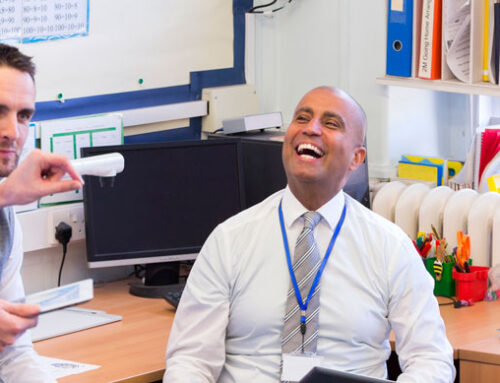As a school administrator, how can you create effective school staff meetings? Likely, you’ve been in all kinds of meetings — some productive and even inspiring, others…not so much. What makes a great staff meeting? We’d love to hear your thoughts! We’ve collected a list of eight things that can help meetings flow and achieve the desired result — ultimately, helping students succeed. But first…
Why are staff meetings important?
Any team needs to have clear, actionable objectives in order to be successful. This is no different for staff in a school. Teachers are responsible for students across multiple subjects and areas of the curriculum. The administrative and support staff are also in frequent communication with others in the district. To support the learning needs of younger children, those in their teens and approaching adulthood, school staff have varying challenges to face. Effective staff meetings are important because they can align school staff to find out how they can best meet student needs. In addition, if a meeting is planned and executed well, school staff will feel that they are being supported and heard.
How to Run an Effective School Meeting
Here are 8 steps that will help you have effective school meetings, from start to finish:
- Create teams
- Set team norms
- Develop a meeting agenda
- Take notes!
- Develop a goal
- Create and assign tasks to accomplish your goal
- Track tasks and follow up
- Acknowledge accomplishments
We’ll break these down one by one, and show you how Team Agendas can help in each step of the process.
1. Create Teams
The first place to start is to divide school staff into teams. Creating teams is important, especially in large schools, because it allows for more meaningful conversations and gives more staff members the opportunity to contribute. A large, school-wide meeting with maybe only one or two people doing the talking won’t have the same outcome as a team-based approach.
You may also have different teams to serve different purposes. There could be a 5th Grade Team or Science Team, to address challenges or initiatives for those specific grade levels or subject areas. To serve other purposes, for example, a school or district-wide goal, there would be value in creating teams that are varied, across multiple grade levels and staff types. In Team Agendas, you can create as many teams as you want, and edit them as needed. You can also assign one or more staff members as team leads, as well as create student groups that the teams are responsible for. But why set a team lead or other roles?
Many schools have found this beneficial because this way everyone knows what their job is. For example, at each meeting, there could be a facilitator who leads the discussion, staff assigned to take notes, and a timekeeper who will help keep the agenda on track.
2. Set Team Norms
Meeting norms, or expectations of behavior for the meeting, can be set by each team, or could even be school-wide and adopted by each team. This could include things like ‘be respectful’ and ‘listen to all ideas.’ Creating a set of norms will help all team members stay on task and feel comfortable expressing themselves. This, in turn, will lead to better communication and more effective school meetings.
In Team Agendas there is an option to set norms for each team. Any team member has the accessibility to add or edit a norm.
3. Develop an Agenda
If your meetings don’t have an agenda, staff members may wonder why they’re even there, and meetings will be frustrating instead of effective. For primary school teachers, who already have a heavy workload, short planning periods, and numerous before and after school duties, staff meetings are one more thing added to their schedule. So have a clear agenda.
This will involve the layout of the meetings, how long it will take, who will be speaking, what they will be speaking about, and how long they will be speaking about it. Will there be a discussion section? Are there questions prepared for this discussion? What is the desired outcome? School staff members have a lot on their plates as it is. An agenda can be set at the team level, school level, or even district level depending on the purpose of the meeting.
Sticking to the agenda items and their timing will help staff to feel more excited about meetings. Emailing the agenda ahead of time so that they are able to prepare, as well as including time for them to share within the agenda itself will boost participation and morale.
Within the agenda itself, Team Agendas allows you to add items and select the type of agenda item. For example, you can label an introduction item or a discussion item. You are able to create your own labels for these agenda items within the application.
4. Take Notes
Housekeeping during the meeting doesn’t have to be tedious. Team Agendas includes a text editor right within the application that is connected to your specific meeting agenda. Taking notes is important because it provides a record of what was discussed, as well as preserving key points staff will want to remember. Your meeting notes and minutes will give evidence of the work and effort that went into the meeting, as well as help your team members to see that their participation was worthwhile.
5. Develop a Goal
The goal is really what your whole meeting revolves around. You may have had a goal even before beginning the meeting. Maybe the goal was the basis for creating the meeting agenda. For some, however, the creation of a goal may be the very purpose of the meeting. There may be an issue identified, or a broader goal such as providing enrichment for students in your school. Within that broader goal, staff will need to communicate smaller goals to achieve that. For example, one team may set a goal to do one enrichment activity with their students each week. This goal contributes to the larger, school-wide goal, and can be tracked by each team member.
But how do you track your goals and make sure there is tangible evidence that goals are being worked on?
6. Create and Assign Tasks
Once a goal is clearly identified, staff can come up with tasks that will lead to the completion of that goal. Tasks can be created right in Team Agendas. They will be connected to your agenda, as well as the goal you’ve set. You can assign a task with its name, a description of the task, and a target date of completion to a specific staff member.
7. Track Tasks and Follow Up
Everyone likes to see progress. As an administrator, of course, you want to see that, but you also want your staff to see that progress as well. Teachers work extremely hard. Within Team Agendas, you and your staff can easily track tasks and see the payoff of all their hard work. As tasks are completed, check them off and watch your goal completion progress get closer and closer to 100%.
This is especially valuable during meetings. It allows teams to look at where they are, and where they need to go. It makes it easy to identify what’s working and what isn’t, the things that are easy to do, and the things that might need more time. The satisfaction that comes from checking off all the tasks, and seeing a goal completed will make meetings feel worthwhile.
8. Acknowledge Accomplishments
Celebrate success! A successful meeting will leave teams walking away with a sense of purpose, and hopefully, reignite their passion. That is a celebration in and of itself! The accomplishment of tasks should be acknowledged within teams, or perhaps could be mentioned to the entire school meetings. Accomplishing goals, small and large, is also cause for acknowledgment. If all teams are working towards one common goal, they will appreciate seeing progress, and be inspired by the work of other staff members. When a school or district-wide goal is met, celebrate the results of all of that hard work.
These 8 steps are key to having effective school staff meetings. In addition, some school leaders have shared that focusing on relationship-building between staff members, incorporating humor, and keeping things lighthearted where possible make meetings something staff want to be a part of. And something you, the teachers at your school, and your students probably all recognize is that snacks make everything a little better. Could you provide some healthy refreshments? Also, consider the general atmosphere of the room. If it’s within your control, could you make the seating more inviting, ensure the room is at a comfortable temperature, and even consider some background music? Small things like this often help staff relax and feel more open to discussion.
Our goal at Team Agendas is to help schools streamline and simplify the process of school staff meetings. As a primary school administrator, you have a lot of responsibilities on your hands. Teachers do too, and we recognize that their time, and yours, is precious. To try out Team Agendas, schedule a demo.
Overall takeaways:
- Assign specific roles to specific team members
- Send staff the agenda ahead of time, give them time to prepare
- Have a clear, actionable goal






